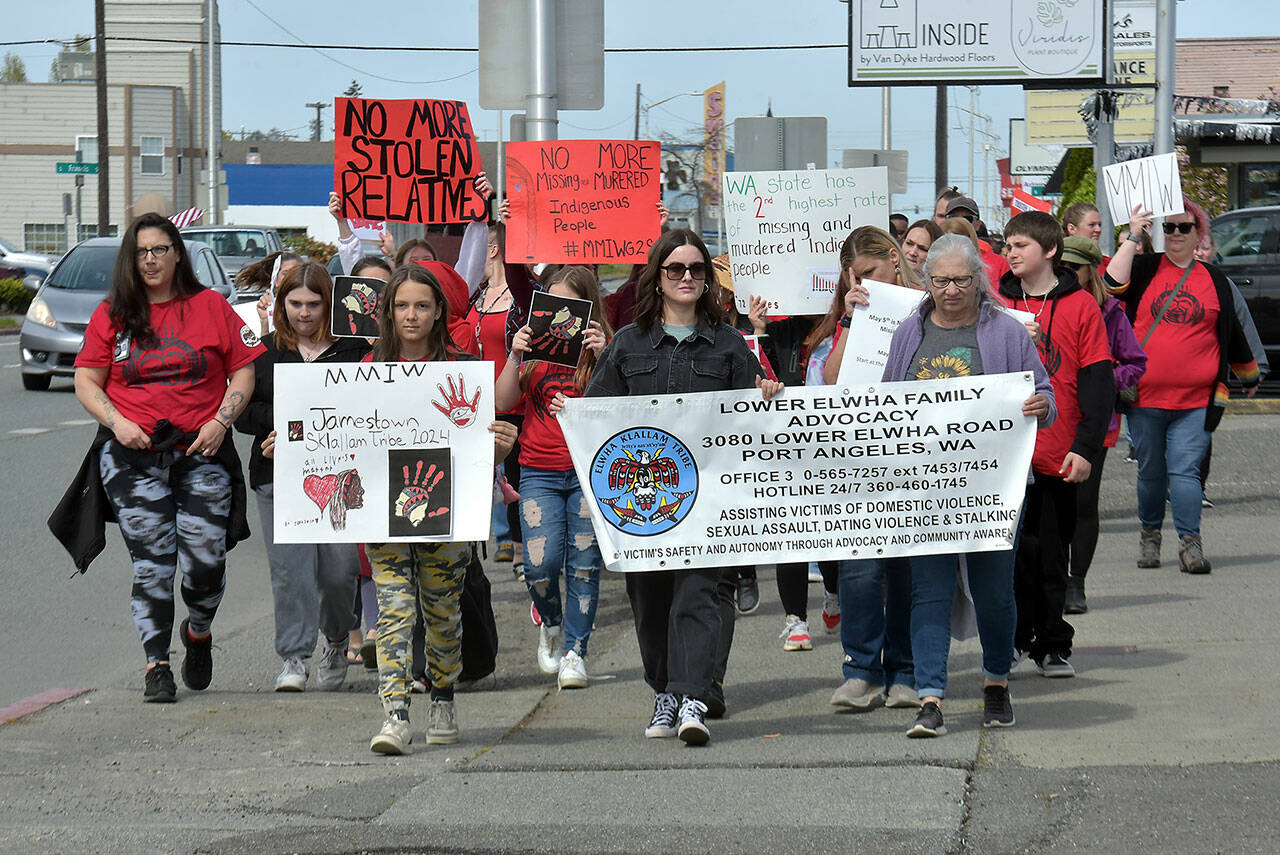PORT ANGELES — About 200 people, most wearing red and carrying signs, marched down First Street in Port Angeles in a demonstration honoring missing and murdered Indigenous people locally and across the nation.
“Our people struggle. We need advocates and we need our voices heard,” said Melissa Gillman, secretary/treasurer of the Lower Elwha Klallam Tribe.
Marchers walked Friday from the Lower Elwha Klallam Tribe’s Heritage Center on First Street to Civic Field and back, in solemn remembrance of an epidemic impacting indigenous communities.
“It’s a very important acknowledgment to the families that, for many years, have not been able to talk about it,” said Frances Charles, Lower Elwha Klallam Tribal chairwoman. “It’s something that’s finally coming to the forefront for tribal families, tribal communities; all of those that have lost and been frustrated in many ways not to have the enforcement.”
Friday’s recognition included a shawl ceremony, where different colored shawls were placed over empty chairs to represent different groups of missing people, including women, men, sexual assault victims and LGBT people.According to a 2016 study by the National Institute of Justice, more than four in five American Indian and Alaska Native women (84 percent) have experienced violence in their lifetime, including 56 percent who have experienced sexual violence.
In the year leading up to the study, 39 percent of American Indian and Alaska Native women had experienced violence, including 14 percent who had experienced sexual violence.
But for many years, jurisdictional issues between tribal and non-tribal law enforcement agencies and the absence of policies, coordination and relationships between those entities made addressing the issue difficult.
In 1978, the U.S. Supreme Court ruled in Oliphant v. Suquamish Indian Tribe that tribes did not have criminal jurisdiction over non-tribal citizens.
“This meant that federally-recognized tribes had no authority to criminally prosecute non-Indians who commit these, even for crimes committed in Indian Country,” the NIJ study added. “This essentially provided immunity to non-Indians and compromised the safety of American Indian and Alaska Native women and men.”
Bills addressing jurisdictional issues have been passed over the years, including a 2013 reauthorization of the Violence Against Women Act and, in 2020, President Donald Trump signed Savanna’s Act and the Not Invisible Act, which sought to clarify law enforcement responsibilities with respect to missing or murdered Indigenous people.
Attempts to address the MMIP issue date back decades, but it’s only in the past few years that the issue has gained national attention. Congress passed a resolution in 2017 recognizing May 5 as Missing or Murdered Indigenous Persons Awareness Day and in 2021 President Joe Biden issued a proclamation in recognition of the day.
Though state and federal authorities have passed multiple bills and started numerous programs, tribal leaders say there’s still more to be done.
In 2021, the state Attorney General’s Office started a 23-member task force to study the issue, and in November, the task force issued a report with five recommendations on how to address the issue.
Lower Elwha Police Chief Sam White was one of the members of the task force and on Friday said the state had made progress with its Missing Indigenous Person Alert System — a special alert system for law enforcement agencies to notify when an indigenous person has been reported missing.“They did a good thing with getting the alert system out, which is allowing us to get an alert system through (Washington State Patrol) for Native Americans,” White said. “Getting that message out to the law enforcement is getting a lot better than when it was first rolled out.”
The state also created a cold case unit for investigating missing Indigenous people, and while White lauded the creation of the unit, he suggested it be placed under the authority of the Office of Independent Investigation, which has the power to prosecute crimes.
“If they were to take this cold case unit and move it to just be a sub-branch of OII,” White said, “it would allow them to take over a case and actually bring it to court rather than being an investigative leg, but they don’t have the authority or the ability to take a case to court.”
Charles said the programs that have been started need more funding to do their job.
“I think there needs to be more funding that is set aside for it,” Charles said. “They started the process, but there’s still shortfalls. They need to be more serious about it.”
________
Reporter Peter Segall can be reached by email at peter.segall@peninsuladailynews.com.

